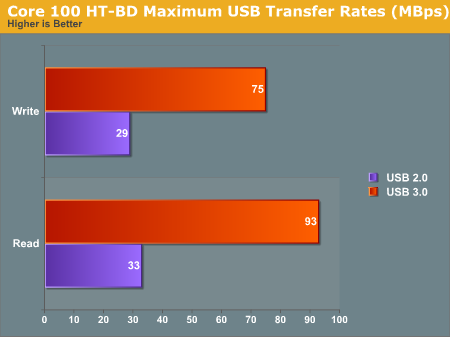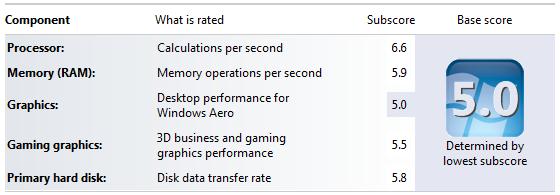ASRock Core 100HT-BD : Bringing HTPCs to the Mainstream Market [UPDATED : Noise Issue]
by Ganesh T S on July 19, 2010 9:34 PM EST- Posted in
- Home Theater
- Arrandale
- ASRock
- Media Streamer
- Core i3
- HTPC
Do the usual benchmarks really provide us with a proper indicator of the worthiness of a HTPC? Is that the performance seen by an average user in real life situations? Such questions often crossed my mind when I looked up the reviews of PCs on various websites. It is almost blasphemous if one were to suggest that the 'Windows Experience Index' is a reflection of what the average user sees. Such a synthetic benchmark might not be a true reflection of the capabilities of the system, but it at least gives an idea to the users as to how much better the system would be compared to the one they currently possess. HTPCs require a different set of performance measurement tests, and we will handle them in the next set of sections. In this, however, we will talk about the general performance metrics in brief.
For readers wanting a lowdown on the core performance aspect (in other words, graphs for various standardized benchmarks) of the motherboard used in this PC, I would suggest reviews from Legion Hardware and Benchmark Reviews. We found nothing in our experiments to dispute their findings. However, one important aspect we would like to cover here is the USB 3.0 performance.
USB 3.0 on the HM55 Chipset
We hooked up OCZ's Enyo 128 GB USB 3.0 external SSD (which has received glowing reviews everywhere with upto 200 MBps read and 190 MBps write speeds) to the front USB 3.0 ports of the Core 100 HT-BD. Contrary to our expectations, we managed to get a maximum of only 93 MBps read and 75 MBps write performance out of the drive. Connecting the same SSD to an USB 2.0 port resulted in a maximum of 33 MBps reads and 29 MBps writes, in line with expectations. We do not get the fabled 10x, but only a 2.7x, improvement over USB 2.0 with the Core 100 HT-BD's USB 3.0 implementation.

A little more analysis revealed that the HM55 chipset does not support PCI-E v2 fully and the bandwidth is limited by the chipset. To get around this limitation, ASRock could have placed a PLX bridge chip on board. We covered this workaround in detail in an earlier piece, but it doesn't make sense for ASRock to implement it in this product. The existing limitation will not be of concern to most users, as SSDs are yet to go mainstream (because of their cost). Most external hard disks with USB 3.0 or eSATA interfaces are inherently limited by the disk-to-buffer transfer rate of around 70 - 90 MBps, and ASRock's USB 3.0 implementation is capable of handling such bandwidth.
Windows Experience Index
A quick glance through the specifications of the system easily reveals the bottleneck affecting the score on the Windows Experience Index. It is none other than Intel's integrated GPU which ends up being the culprit. A screenshot of the Windows Experience Index shows the system chiming in at 5.0. However, we have seen the scores oscillate between 4.4 and 5.2 depending on the graphics driver version, as well as the GPU overclocking status.

Of particular interest is the impressive score received by the processor (6.6), indicating that the performance of this unit would be more than enough for most, if not all, HTPC applications.
DPC Latency Check
Another important criterion for HTPCs is the ability of the system to handle real time streaming of audio and video without dropouts. A handy tool called the DPC Latency Checker helps in analyzing this. This tool was run multiple times in various HTPC scenarios. We did observe red spikes, but disabling the C-states, as well as SpeedStep in the BIOS Advanced CPU configuration helped in alleviating the issue. However, we did not observe any dropouts or playback issues with Blu-Ray or any other media despite the sporadic occurrence of these spikes.
Miscellaneous Performance Indices
Pre-built HTPCs available today are mostly based on the ION chipset, and any comparative evaluation of the benchmark results of this system with ION systems would be grossly unfair for the ION. Both Benchmark Reviews and Legion Hardware compared the Core 100 HT with the ION 330, the 2009 HTPC model from ASRock. Comparing the performance of the Atom to the Core i3 is like comparing apples to oranges, but, for the record, the Core 100 HT system came out better on almost all counts except for the 3D and gaming performance.
On the memory bandwidth side, the Core 100 has more than 2x the performance of the ION 330. CPU performance is around 4 - 5x better. While games appeared to achieve almost similar frame rates on both the Core 100 and the ION 330, 3D performance in applications such as Maya went down by a factor of 2x in favour of the ION 330. Thankfully, applications such as video encoding (a common overnight task for most HTPCs) see a 3.5x performance improvement in the Core 100HT-BD.
In the next section, we will look at the integrated GPU of the Core i3-330M in detail.










107 Comments
View All Comments
spddemon - Tuesday, July 20, 2010 - link
This system is capable of dobly truHD and DTS HD. A ION system is not capable of decoding of those sounds format...So this system will appeal heavily to someone that wants a small nettop type system with a BD and good encoding performance. With any nettop you are going to have to use NAS storage anyways, but this system will allow more internal expansion than most others.. But if you wanted to, you could pair it with an external drive cage.. I wouldn't want that in my living room / theater room though.
biggest problem with this system is price.. You can build a great system for a couple hundred less if you are willing to take hours of researching the components and integration. A successful HTPC build will take considerable more time in planning/research than a typical PC/Gaming PC Build....
If you are wanting a powerful, small, efficient, prebuilt nettop, this is the best out there right now!
That is really the only thing i wish Ganesh would of pointed out a little more clearly. The capabilities of the "iGPU" vs an ION.. with the growth of this field, I would love to see a followup review that would pit a custom built (but comparable build) HTPC.. like a Core i3 530 (or maybe an e7200) / H55 with and without an ATI/NVIDIA (non ION) card. This would really give some people something to look at as far as capabilities..
and really, who cares what the remote looks like.. get a Logitech harmony or some other home automation remote... most people will only care about if the IR or RF functionality is already there...
ganeshts - Tuesday, July 20, 2010 - link
spddemon,Stay tuned for more HTPC reviews in this space. Their performance will be pitted against this solution.
However, ION is passe right now. We will be testing with the ATI 5xxx series and upcoming Nvidia cards.
Furuno - Wednesday, July 21, 2010 - link
Upcoming nVidia cards...Hmm I wonder what it is... A low-cost version of fermi or another rebranding of GT2XX cards?
ganeshts - Wednesday, July 21, 2010 - link
We already published reviews of the GTX460 from the gaming perspective.The card is good from a gaming HTPC perspective because it also supports HD audio bitstreaming.
There are some rumours that Nvidia has lower priced cards coming out in the next 2 months, so we will cover them when they get released :) At the least, we will cover the GTX460.
spddemon - Wednesday, July 21, 2010 - link
Thanks for the updates Ganeshts!It looks like your time frame will be perfect for my new HTPC project.
I really hope Nvidia can get some low powered cards out to offer a true HTPC card that covers all the current HD formats/codecs.
mindbomb - Wednesday, July 21, 2010 - link
Ion can only bitstream LPCM, but I assume the atom cpu is powerful enough to decode truehd in libavcodec.So that only leaves DTS-HD MA as a problem.
ganeshts - Tuesday, July 20, 2010 - link
Goty,The user can always opt for a USB TV tuner.
If we had an expansion slot for a TV tuner inside this box, the unit wouldn't be based off the HM55 chipset, and wouldn't fit in the sub-50 W power envelop which is a coveted mark in this space.
Further, including a TV tuner in the box would drive up the cost of the system in some areas, as it would be taxed as an entertainment device, rather than a computer.
bearxor - Tuesday, July 20, 2010 - link
No one that is serious about using this as a HTPC is going to string USB TV tuners off this thing. You want 2 USB tuners hanging off the back of the machine? How about 4?My HTPC has 7 tuners total. 2xHauppage 2250's, 2xCats Eye 150's and a ATi DCT. Tell me exactly where I'm going to be able to put those on a machine like this.
There needs to be some kind of market differentiation between a HTPC and a Living Room PC. One is for serious use as a DVR and the other is to hook up to the TV and watch some videos/play games/surf the web/Facebook/chat, etc. They are two different markets.
ganeshts - Tuesday, July 20, 2010 - link
bearxor,You have got an impressive set up.
However, I believe your type of setup is more the exception rather than the norm. The sort of arrangement which will remain a niche for a long time to come. With the advent of IP streaming and availability of TV shows and live sports broadcasts online, I am not even sure people will require so many tuners.
I also think that your sort of setup isn't amenable to the silent, power efficient HTPC that people want (particularly from the viewpoint of media streamers and boxes such as the upcoming Google TV). The latter 'living room PC' that you mention has more potential to explode as a market for manufacturers to exploit, rather than the DVR-centric PC that you envisage.
hughlle - Tuesday, July 20, 2010 - link
Exactly, 7 tuners is hardly the norm. I make do without a single one on my HTPC, i have the likes of iplayer if i really feel inclined to drop into the fantastic realm that is daytime television :S